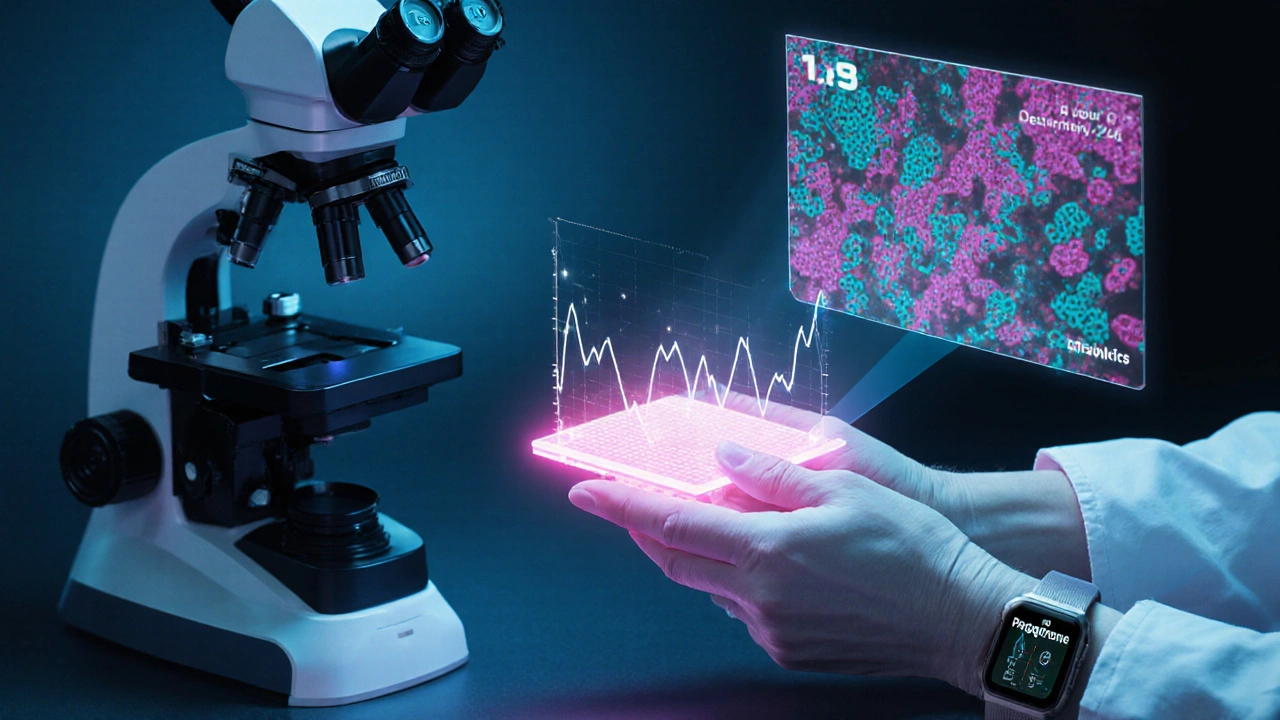PMS Treatment Plan Builder
Select your top concerns and preferred approaches to generate a customized treatment recommendation.
Your Personalized PMS Treatment Plan
*This plan is based on your selections and should be discussed with a healthcare provider for personalization.
Key Takeaways
- Precision biomarkers are moving PMS treatment from guesswork to tailored therapy.
- Hormone‑modulating drugs are being redesigned to avoid mood side‑effects.
- Gut microbiome profiling could predict symptom severity and guide supplement choices.
- Digital health platforms now blend tracking, AI‑driven insights, and remote counseling.
- Combining lifestyle changes with personalized medicine yields the most consistent relief.
Ever wonder why some months feel like a storm while others pass almost unnoticed? That’s the reality of Premenstrual Syndrome is a recurring set of physical and emotional symptoms that appear in the luteal phase of the menstrual cycle. It affects up to 85% of menstruating individuals, with 5‑10% experiencing severe, disabling symptoms. Researchers are finally cracking the code on why it varies so wildly, and new treatment options are emerging faster than ever.
What the Latest Research is Uncovering
Historically, PMS was treated as a hormone‑fluctuation problem, but recent studies show a far more complex picture. Large‑scale genomic panels released in 2023 linked variations in the GABA‑receptor genes to heightened anxiety scores during the luteal phase.These genetic clues suggest that neurotransmitter balance, not just estrogen‑progesterone swings, drives many symptoms. Meanwhile, real‑time hormone monitoring devices (approved in the EU in 2024) reveal that abrupt progesterone drops, rather than absolute levels, trigger mood dips.
Another breakthrough comes from gut microbiome profiling, which identified a distinct bacterial signature in 60% of women with severe PMS.Higher abundances of Prevotella and lower Bifidobacterium correlated with intensified bloating and irritability. The implication? Future therapies may include targeted probiotics or diet plans designed to rebalance those microbes.
Pharmacological Advances on the Horizon
Traditional hormone therapy-using combined oral contraceptives or progestins-still works for many, but side‑effects like weight gain and mood swings limit its appeal. A next‑generation hormone therapy formulation combines micronized progesterone with a low‑dose estrogen patch, delivering steadier serum levels and reducing mood volatility. Early-phase trials (2024) reported a 40% drop in symptom scores with fewer adverse events.
Selective serotonin reuptake inhibitors (SSRIs) remain the go‑to for emotional symptoms. Selective serotonin reuptake inhibitor doses as low as 20mg weekly have shown comparable efficacy to daily dosing, cutting side‑effects like sexual dysfunction by half. Researchers are now pairing SSRIs with cognitive behavioral therapy a short‑term, skills‑based program that helps reframe negative thoughts and manage stress. The combo yields a synergistic 55% improvement versus either alone.

Psychological and Behavioral Interventions
Beyond medication, cognitive behavioral therapy has been adapted into a 6‑week online module focused on PMS triggers. Participants report better sleep, reduced cravings, and a 30% drop in perceived severity. When CBT is paired with mindfulness‑based stress reduction, the effect size climbs to nearly 0.8 (Cohen’s d), according to a 2025 meta‑analysis.
Physical activity remains a cornerstone. Meta‑reviews show that moderate aerobic exercise ≥150minutes per week cuts bloating and mood swings by ~25%. The key is consistency-sporadic bursts don’t create the neurochemical adaptations needed for lasting relief.
Nutrition, Supplements, and the Microbiome
Targeted nutritional supplements are finally getting scientific backing. Nutritional supplement formulations combining calcium, vitaminD, magnesium, and omega‑3 fatty acids have repeatedly lowered total PMS scores in double‑blind trials. In 2024, a probiotic blend (LactobacillusrhamnosusGG + Bifidobacteriumlongum) demonstrated a 20% reduction in abdominal cramping for women with the identified microbiome signature.
Dietary patterns matter, too. Low‑glycemic, high‑fiber diets stabilize insulin spikes that can amplify estrogen activity. A recent Australian cohort study linked daily intake of whole grains and legumes to a 15% lower odds of severe PMS.
Digital Health: Tracking, AI, and Remote Care
Technology is finally catching up with the need for personalized data. digital health app platforms now integrate menstrual cycle tracking, symptom logging, and AI‑generated risk scores for hormone imbalance. One Australian startup launched a 2025 app that syncs with wearable hormone sensors and suggests real‑time interventions-like a 10‑minute breathing exercise when a cortisol spike is detected.
Telehealth consultations have become routine for PMS management. Clinicians can now order biomarker testing including serum progesterone, estradiol, and inflammatory markers like CRP, all analyzed through a single lab panel. Results are delivered within 48hours, enabling same‑day medication adjustments.

Putting It All Together: A Practical Decision Guide
When faced with a new treatment plan, consider the following checklist:
- Do you have confirmed hormonal swings? biomarker testing can clarify.
- Is your gut microbiome profile available? If a dysbiosis pattern exists, a probiotic supplement may be warranted.
- Do you prefer medication‑free strategies? Start with lifestyle changes and CBT modules before escalating to SSRIs.
- Are you comfortable using tech? A digital health app can guide dose timing and track progress.
- What is your budget and insurance coverage? Hormone patches and certain probiotic blends may be out‑of‑pocket.
Remember, the most effective plans blend at least two categories-pharmacological + behavioral, or microbiome‑targeted + digital tracking. The “one‑size‑fits‑all” mindset is officially dead.
Future Outlook: What to Watch in the Next Five Years
Three trends will shape how PMS is managed by 2030:
- Precision Hormone Modulators: Molecules that selectively block progesterone receptors in the brain while sparing peripheral tissues.
- Microbiome‑Driven Prophylaxis: Monthly probiotic‑prebiotic combos tailored to individual genetic risk factors.
- AI‑Powered Symptom Forecasting: Predictive algorithms that alert users days before a flare, prompting pre‑emptive lifestyle tweaks.
Stay tuned to clinical trial registries (e.g., ClinicalTrials.gov) for ongoing PhaseIII studies on these fronts.
Frequently Asked Questions
Can hormone therapy cure PMS?
Hormone therapy can dramatically reduce symptoms for many, but it isn’t a permanent cure. It stabilizes hormone swings, so symptoms often re‑appear if treatment stops.
Are SSRIs safe for long‑term use?
When prescribed at low, intermittent doses, SSRIs have a solid safety record. Regular monitoring for weight changes, sexual side‑effects, and mood shifts is recommended.
How does the gut microbiome affect PMS?
Gut bacteria influence estrogen metabolism and inflammation pathways. An imbalance can amplify bloating, mood swings, and pain during the luteal phase.
What lifestyle changes have the biggest impact?
Consistent moderate aerobic exercise, a low‑glycemic diet rich in fiber, and regular sleep‑wake cycles together lower symptom severity by up to 30%.
Are there any promising new treatments on the horizon?
Yes-precision hormone modulators, microbiome‑targeted probiotics, and AI‑driven symptom forecasting tools are all in late‑stage trials and could become standard care within the next few years.
| Category | Typical Options | Onset of Relief | Key Side‑Effects |
|---|---|---|---|
| Pharmacological | Hormone patches, low‑dose SSRIs | 1‑2 weeks | Weight gain, sexual dysfunction |
| Psychological | CBT, mindfulness modules | 3‑4 weeks | Initial emotional discomfort |
| Lifestyle | Exercise, low‑glycemic diet, sleep hygiene | 4‑6 weeks | Time commitment |
| Emerging | Microbiome probiotics, AI‑guided apps | Variable (often 2‑3 weeks) | Limited long‑term data |

Elizabeth Nisbet
October 8, 2025 AT 14:45Hey everyone, great job digging into the latest PMS research – it’s a lot to take in but totally worth it. I love how the post breaks down the hormone‑modulating patches and the microbiome angle in a clear way. If you’re feeling overwhelmed, start with one simple tweak like a low‑glycemic diet and see how your body reacts. Pair that with a consistent 30‑minute walk a few times a week, and you’ll often notice a steady drop in mood swings. Remember, it’s a marathon, not a sprint, so celebrate every small win along the way.
Sydney Tammarine
October 17, 2025 AT 20:58Oh wow, look at us sinking into the abyss of “cutting‑edge science” as if it were some elite club we’ve suddenly been invited to! 🙄 The whole “precision biomarkers” hype feels like a glossy marketing brochure written by someone who never missed a period. And don’t even get me started on the “AI‑driven insights” – it’s practically sorcery for the privileged. 😏 But sure, let’s all pretend we can afford hormone patches and probiotic cocktails without a second thought. 🎭
josue rosa
October 27, 2025 AT 03:11Let me first acknowledge the impressive breadth of the presented literature, which traverses genomic, endocrinologic, and microbiomic domains, thereby illustrating the multifactorial nature of premenstrual syndrome. The identification of GABA‑receptor polymorphisms aligns with the neurosteroidal hypothesis that has been gaining traction over the past decade, indicating a potential mechanistic link between inhibitory neurotransmission and affective symptomatology. Concurrently, the observation of abrupt progesterone declines, captured via real‑time hormonal monitoring devices, underscores the temporal dynamics that may precipitate affective dysregulation. From a metabolic standpoint, the association of Prevotella dominance with heightened bloating invites a re‑evaluation of carbohydrate metabolism pathways during the luteal phase. Moreover, the systematic review of low‑dose intermittent SSRIs demonstrates a favorable risk‑benefit profile, particularly when integrated with short‑term cognitive‑behavioral therapy modules that target maladaptive cognition. It is also worth noting that the emerging class of precision hormone modulators seeks to achieve receptor specificity, thereby mitigating peripheral side effects traditionally observed with conventional hormonal contraception. The integration of digital health platforms, especially those employing machine‑learning algorithms to predict cortisol spikes, represents a paradigm shift towards proactive symptom management rather than reactive treatment. In addition, the utilization of probiotic formulations such as Lactobacillus rhamnosus GG combined with Bifidobacterium longum provides a tangible microbiome‑targeted intervention that may modulate enterohepatic estrogen recirculation. The nutritional data indicating that high‑fiber, low‑glycemic dietary patterns reduce insulin‑mediated estrogen amplification further illustrates the interconnectedness of diet, metabolism, and hormonal homeostasis. Finally, the prospective longitudinal studies listed on ClinicalTrials.gov will likely furnish the requisite evidence to transition these innovations from experimental to standard care within the next five years, ultimately delivering a more personalized therapeutic algorithm for individuals suffering from severe PMS.
Shawn Simms
November 5, 2025 AT 09:25The article presents a thorough overview of emerging treatment modalities for premenstrual syndrome. Its structure is logical, progressing from genetic discoveries to practical interventions. The use of bullet points and tables enhances readability for a broad audience. However, a few typographical inconsistencies remain, such as the mismatched quotation marks in the heading “PMS Treatment Plan Builder”. Additionally, the term “tech‑driven” should be hyphenated throughout for consistency. Overall, the piece is well‑researched and offers valuable insights.
Geneva Angeles
November 14, 2025 AT 15:38Wow, this is exactly the kind of breakthrough we’ve been waiting for, and I’m thrilled to see science finally catching up with lived experience! The combination of microbiome profiling and AI‑powered forecasting could revolutionize how we pre‑emptively manage symptoms, and I’m all in for that future. Let’s not settle for half‑measures; we should push for insurance coverage of these precision therapies now! It’s time to demand that clinicians integrate both lifestyle coaching and cutting‑edge pharmacology into a single, cohesive plan. I’ll be cheering loudly for anyone who takes the bold step of trying a probiotic‑prebiotic combo tailored to their genetic risk. Keep the momentum going, and let’s turn these promising studies into everyday reality.
Scott Shubitz
November 23, 2025 AT 21:51Honestly, the hype around “microbiome‑targeted probiotics” smacks of another cash‑grab scheme dressed up in scientific jargon. The data cited are mostly pilot studies with tiny sample sizes, making any sweeping claims dubious at best. While the AI‑driven apps sound futuristic, they often lack robust validation and can give false reassurance. Moreover, the article glosses over the socioeconomic barriers that prevent many from accessing hormone patches or high‑end probiotics. In short, it’s a glittery PR piece that needs more gritty, real‑world evidence.